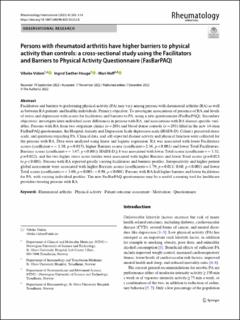| dc.contributor.author | Videm, Vibeke | |
| dc.contributor.author | Houge, Ingrid Sæther | |
| dc.contributor.author | Hoff, Mari | |
| dc.date.accessioned | 2023-04-20T06:36:49Z | |
| dc.date.available | 2023-04-20T06:36:49Z | |
| dc.date.created | 2022-12-15T13:07:27Z | |
| dc.date.issued | 2023 | |
| dc.identifier.citation | Rheumatology International. , . | en_US |
| dc.identifier.issn | 0172-8172 | |
| dc.identifier.uri | https://hdl.handle.net/11250/3063920 | |
| dc.description.abstract | Facilitators and barriers to performing physical activity (PA) may vary among persons with rheumatoid arthritis (RA) as well as between RA patients and healthy individuals. Primary objective: To investigate associations of presence of RA and levels of stress and depression with scores for facilitators and barriers to PA, using a new questionnaire (FasBarPAQ). Secondary objectives: investigate inter-individual score differences in persons with RA, and associations with RA disease-specific variables. Persons with RA from two outpatient clinics (n = 203) and blood donor controls (n = 293) filled in the new 14-item FasBarPAQ questionnaire, the Hospital Anxiety and Depression Scale depression scale (HADS-D), Cohen’s perceived stress scale, and questions regarding PA. Clinical data, and self-reported disease activity and physical function were collected for the persons with RA. Data were analyzed using linear and logistic regression. RA was associated with lower Facilitators scores (coefficient = − 1.30, p = 0.015), higher Barriers scores (coefficient = 2.36, p < 0.001) and lower Total Facilitators-Barriers scores (coefficient = − 3.67, p < 0.001). HADS-D ≥ 8 was associated with lower Total scores (coefficient = − 3.32, p = 0.022), and the two higher stress score tertiles were associated with higher Barriers and lower Total scores (p = 0.023 to p < 0.001). Persons with RA reported greatly varying facilitators and barriers profiles. Seropositivity and higher patient global assessment were associated with higher Barriers scores (coefficients = 1.79, p = 0.011; 0.60, p < 0.001) and lower Total scores (coefficients = − 3.60, p = 0.003; − 0.98, p < 0.001). Persons with RA had higher barriers and lower facilitators for PA, with varying individual profiles. The new FasBarPAQ questionnaire may be a useful screening tool for healthcare providers treating persons with RA. | en_US |
| dc.language.iso | eng | en_US |
| dc.publisher | Springer Nature | en_US |
| dc.rights | Navngivelse 4.0 Internasjonal | * |
| dc.rights.uri | http://creativecommons.org/licenses/by/4.0/deed.no | * |
| dc.title | Persons with rheumatoid arthritis have higher barriers to physical activity than controls: a cross-sectional study using the Facilitators and Barriers to Physical Activity Questionnaire (FasBarPAQ) | en_US |
| dc.title.alternative | Persons with rheumatoid arthritis have higher barriers to physical activity than controls: a cross-sectional study using the Facilitators and Barriers to Physical Activity Questionnaire (FasBarPAQ) | en_US |
| dc.type | Peer reviewed | en_US |
| dc.type | Journal article | en_US |
| dc.description.version | publishedVersion | en_US |
| dc.source.pagenumber | 303–314 | en_US |
| dc.source.volume | 43 | en_US |
| dc.source.journal | Rheumatology International | en_US |
| dc.identifier.doi | 10.1007/s00296-022-05252-8 | |
| dc.identifier.cristin | 2093750 | |
| cristin.ispublished | true | |
| cristin.fulltext | original | |
| cristin.qualitycode | 1 | |

